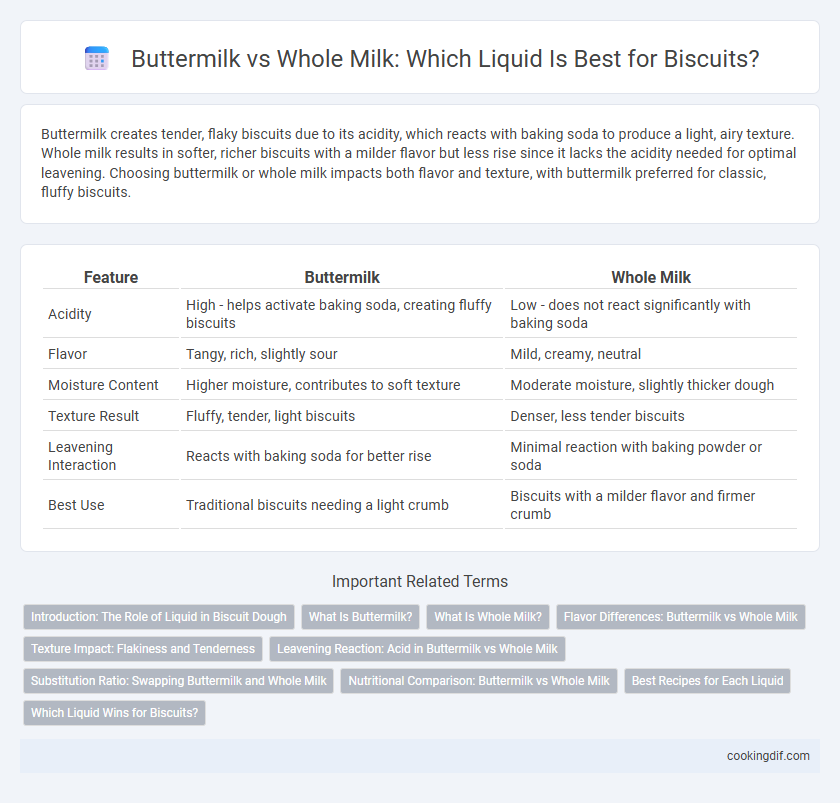Buttermilk creates tender, flaky biscuits due to its acidity, which reacts with baking soda to produce a light, airy texture. Whole milk results in softer, richer biscuits with a milder flavor but less rise since it lacks the acidity needed for optimal leavening. Choosing buttermilk or whole milk impacts both flavor and texture, with buttermilk preferred for classic, fluffy biscuits.
Table of Comparison
| Feature | Buttermilk | Whole Milk |
|---|---|---|
| Acidity | High - helps activate baking soda, creating fluffy biscuits | Low - does not react significantly with baking soda |
| Flavor | Tangy, rich, slightly sour | Mild, creamy, neutral |
| Moisture Content | Higher moisture, contributes to soft texture | Moderate moisture, slightly thicker dough |
| Texture Result | Fluffy, tender, light biscuits | Denser, less tender biscuits |
| Leavening Interaction | Reacts with baking soda for better rise | Minimal reaction with baking powder or soda |
| Best Use | Traditional biscuits needing a light crumb | Biscuits with a milder flavor and firmer crumb |
Introduction: The Role of Liquid in Biscuit Dough
Liquid plays a crucial role in biscuit dough by hydrating the flour's proteins and starches, which enables gluten development and contributes to the dough's texture. Buttermilk, with its acidic properties and thicker consistency, reacts with baking soda to create a tender, flaky biscuit. Whole milk provides moisture and richness but lacks the acidity that enhances rise and flavor, making buttermilk the preferred choice for achieving optimal biscuit quality.
What Is Buttermilk?
Buttermilk is a fermented dairy product with a tangy flavor and thicker consistency compared to whole milk, making it ideal for biscuit recipes that require a tender crumb and slight acidity. The natural acidity of buttermilk reacts with baking soda or baking powder to create light, fluffy biscuits by releasing carbon dioxide gas during baking. Whole milk, while providing moisture and richness, lacks this acidity, resulting in denser, less tender biscuits without the characteristic rise and flavor contributed by buttermilk.
What Is Whole Milk?
Whole milk is a nutrient-rich dairy product containing about 3.25% fat, essential for creating tender and moist biscuits by providing a balanced texture and flavor. Unlike buttermilk, which is fermented and tangier, whole milk offers a mild, creamy taste that enhances the biscuit's crumb without altering its traditional flavor profile. Using whole milk in biscuit recipes delivers consistent results with a soft interior and slightly crisp crust.
Flavor Differences: Buttermilk vs Whole Milk
Buttermilk imparts a tangy, slightly acidic flavor to biscuits, enhancing their overall taste profile with a subtle richness that balances sweetness and savory notes. Whole milk offers a milder, creamier flavor that results in a more neutral base, allowing other ingredients like butter and sugar to dominate the flavor. The acidity in buttermilk also reacts with baking soda to create a tender crumb and slightly tender texture, which is less pronounced when using whole milk.
Texture Impact: Flakiness and Tenderness
Buttermilk enhances biscuit texture by reacting with baking soda to create a tender crumb and exceptional flakiness, while whole milk yields a denser, less airy biscuit due to lower acidity. The acidity in buttermilk breaks down gluten strands more effectively, resulting in a lighter, melt-in-your-mouth texture. Whole milk produces biscuits with a richer flavor but a firmer, less delicate structure.
Leavening Reaction: Acid in Buttermilk vs Whole Milk
Buttermilk contains lactic acid that reacts with baking soda to produce carbon dioxide, creating a lighter, fluffier biscuit texture through enhanced leavening. Whole milk lacks sufficient acidity, resulting in a weaker chemical reaction and denser biscuits when used alone. This acid-base interaction is critical for achieving optimal rise and tenderness in biscuit dough.
Substitution Ratio: Swapping Buttermilk and Whole Milk
Substituting buttermilk with whole milk in biscuit recipes typically requires adjusting the liquid quantity due to buttermilk's thicker consistency and higher acidity. A common substitution ratio is to use 1 cup of whole milk plus 1 tablespoon of lemon juice or vinegar to mimic the acidity of 1 cup of buttermilk, ensuring proper biscuit rise and tenderness. Maintaining this ratio helps achieve the desired texture without compromising the biscuit's flavor or crumb structure.
Nutritional Comparison: Buttermilk vs Whole Milk
Buttermilk contains fewer calories and less fat compared to whole milk, making it a lighter option for biscuit liquid without sacrificing richness. It is higher in protein and provides beneficial probiotics, which can aid digestion and improve gut health. Whole milk offers more saturated fat and calories, contributing to a denser, creamier biscuit texture but with fewer digestive benefits compared to buttermilk.
Best Recipes for Each Liquid
Buttermilk provides biscuits with a tender crumb and a subtle tang, perfect for recipes like Southern buttermilk biscuits that require a balance of richness and acidity, enhancing the rise with baking soda. Whole milk adds moisture and a creamy texture, ideal for softer, milder biscuits such as classic drop biscuits or flaky buttermilk-free varieties. Choosing buttermilk or whole milk depends on the desired flavor profile and texture, with buttermilk excelling in rise and tang, while whole milk offers richness and softness.
Which Liquid Wins for Biscuits?
Buttermilk creates tender, fluffy biscuits due to its acidity, which reacts with baking soda to produce a light, airy texture, while whole milk provides a milder, creamier taste but results in denser biscuits. The choice of liquid directly impacts biscuit rise and crumb structure, making buttermilk the preferred ingredient for achieving a soft interior and flaky layers. Bakers aiming for classic, flavorful biscuits often opt for buttermilk to enhance both texture and flavor profiles.
Buttermilk vs whole milk for biscuit liquid Infographic

 cookingdif.com
cookingdif.com